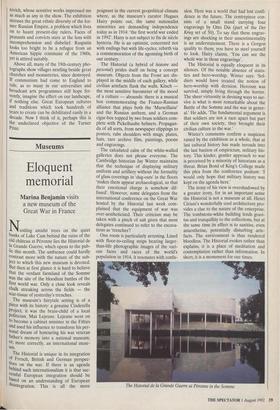Museums
Eloquent memorial
Marina Benjamin visits a new museum of the Great War in France Nestling amidst trees on the quiet banks of Lake Cam behind the ruins of the old château at Peronne lies the Historial de la Grande Guerre, which opens to the pub- lic this month. The ambience could hardly contrast more with the nature of the sub- ject to which this new museum is devoted. But then at first glance it is hard to believe that the verdant farmland of the Somme was the site of the bloodiest battles of the first world war. Only a close look reveals chalk streaking across the fields — the scar-tissue of yesterday's trenches. The museum's fairytale setting is of a piece with its history: a genuine Cinderella project, it was the brain-child of a local politician, Max Lejeune. Lejeune went on to become a cabinet minister in the Fifties and used his influence to transform his per- sonal dream of honouring his war veteran father's memory into a national museum, or, more correctly, an international muse- um.
The Historial is unique in its integration of French, British and German perspec- tives on the war. If there is an agenda behind such internationalism it is that suc- cessful European integration should be based on an understanding of European disintegration. This is all the more poignant in the current geopolitical climate where, as the museum's curator Hugues Hairy points out, the same nationalist minorities are demanding independence today as in 1914: 'the first world war ended in 1992'. Hairy is not subject to fin de siècle hysteria. He is an optimist, concerned not with endings but with life-cycles; rebirth via a commemoration of the agonising birth of our century.
The Historial (a hybrid of histoire and pictorial) prides itself on being a concept museum. Objects from the Front are dis- played in the middle of each gallery, while civilian artefacts flank the walls. Kitsch the most sensitive barometer of the mood of a culture — abounds: there is a musical box commemorating the Franco-Russian alliance that plays both the `Marseillaise' and the Russian anthem, and a German cigar-box topped by two brass soldiers com- plete with Pickelhaube helmets. Propagan- da of all sorts, from newspaper clippings to posters, rubs shoulders with mugs, plates, hats, rare archive film, paintings, poems and engravings.
The calculated calm of the white-walled galleries does not please everyone. The Cambridge historian Jay Winter maintains that the technique of displaying military uniform and artillery without the formality of glass coverings in 'dug-outs' in the floors `makes them appear archaeological, so that their emotional charge is somehow dif- fused'. However, some delegates from the international conference on the Great War hosted by the Historial last week com- plained that the equipment of war was over-aestheticised. Their criticism may be taken with a pinch of salt given that most delegates continued to refer to the excava- tions as `trenches'!
One room is particularly arresting. Lined with floor-to-ceiling strips bearing larger- than-life photographic images of the vari- ous faces and races of the world's population in 1914, it resonates with confu- sion. Here was a world that had lost confi- dence in the future. The centrepiece con- sists of a small stand carrying four engravings by Otto Dix (part of the Der Krieg set of 50). To say that these engrav- ings are shocking in their unsentimentality is an understatement. There is a Gorgon quality to them; you have to steel yourself to look. Hairy claims, 'You can see the whole war in those engravings'.
The Historial is equally eloquent in its silences. Of the notable absence of statis- tics and hero-worship, Winter says: 'Sol- diers would have treated the notion of hero-worship with derision. Heroism was survival, simply living through the horror. The sheer virtuosity in devising ways to sur- vive is what is most remarkable about the Battle of the Somme and the war in gener- al.' He adds, 'The fundamental argument is that soldiers are not a race apart but part of their own society, they brought their civilian culture to the war.'
Winter's comments confirm a suspicion raised by the exhibition as a whole, that at last cultural history has made inroads into the last bastion of empiricism, military his- tory. This kinder, gentler approach to war is perceived by a minority of historians as a threat. Brian Bond of King's College made this plea from the conference podium: 'I would only hope that military history was kept on the agenda here.'
The irony of his view is overshadowed by a greater irony, for in an important sense the Historial is not a museum at all. Henri Ciriani's wonderfully cool architecture pro- vides a clue to the nature of the enterprise. The tombstone-white building lends gravi- tas and tranquillity to the collections, but at the same time its effect is to sanitise, even anaesthetise, potentially disturbing arte- facts. The environment is thus rendered bloodless. The Historial evokes rather than explains, it is a place of meditation and contemplation rather than information. In short, it is a monument for our times.
The Historial de la Grande Guerre at Peronne in the Somme


















































 Previous page
Previous page